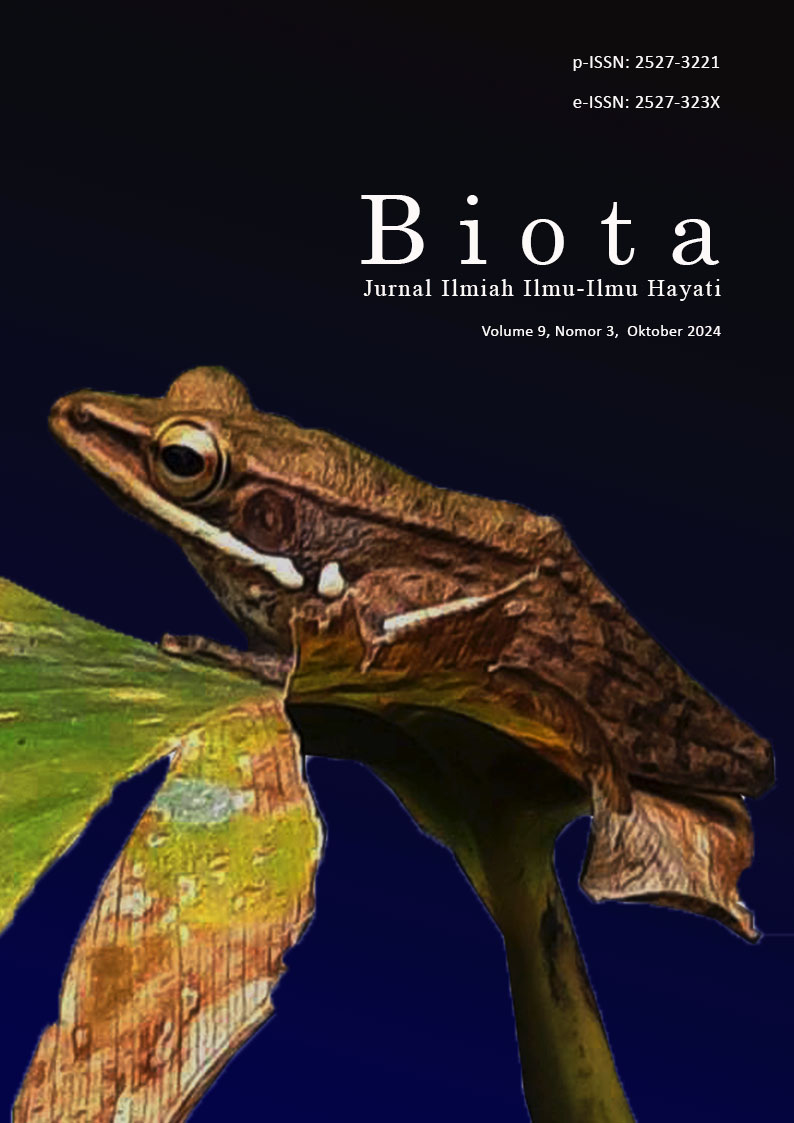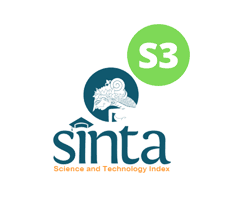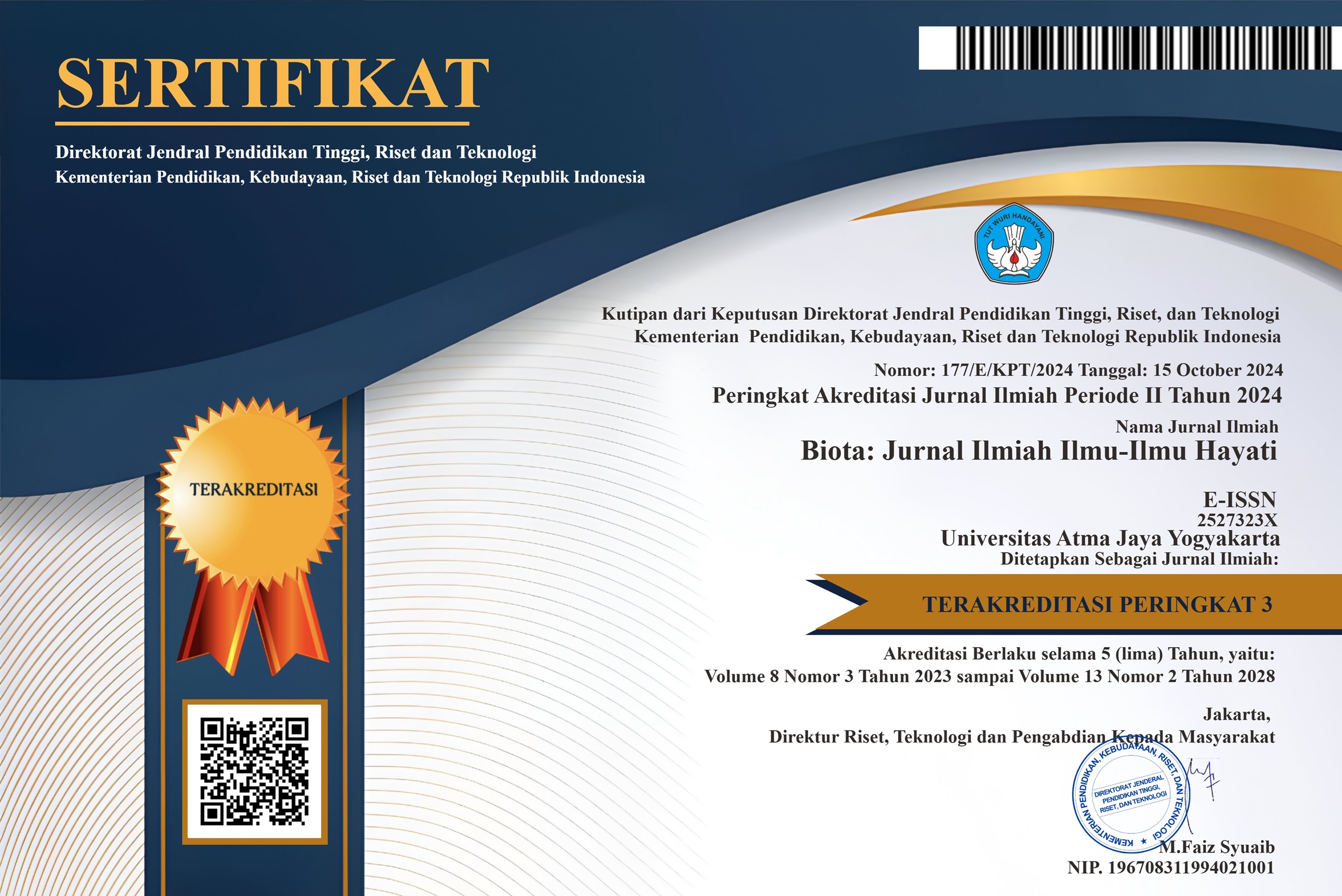Daya Antagonisme Agensia Hayati terhadap Patogen Blendok pada Jeruk Pamelo secara In Vitro
DOI:
https://doi.org/10.24002/biota.v9i3.8559Keywords:
B. theobromae, biokontrol, endofit, tanaman majapahit, jeruk baliAbstract
Produksi jeruk di Kalimantan Selatan mengalami penurunan yang diakibatkan berbagai faktor, diantaranya serangan penyakit. Hal ini juga dialami oleh pertanaman buah jeruk pamelo di Amanah Borneo Park yang sering mengalami gagal panen akibat serangan penyakit blendok yang disebabkan oleh patogen Botryodiplodia theobromae Pat. Pengendalian penyakit dapat dilakukan dengan menggunakan agen hayati, salah satunya cendawan endofit yang bersifat antagonis terhadap penyebab patogen, yang dapat diisolasi dari tanaman obat. Cendawan endofit mampu menghasilkan metabolit sekunder, enzim litik, dan antimikroba lainnya dalam menghambat pertumbuhan patogen tanaman. Tujuan penelitian ini yaitu mengetahui jenis cendawan penyebab penyakit blendok di Amanah Borneo Park dan mengetahui daya antagonisme Trichoderma harzianum, endofit Colletotrichum sp., dan endofit Fusarium sp. terhadap patogen tersebut. Hasil identifikasi mengemukakan bahwa patogen penyebab blendok di Amanah Borneo Park adalah B. theobromae Pat (P2B4), kemudian uji antagonisme dengan tiga agen antagonis yaitu Trichoderma harzianum, endofit Colletotrichum sp., dan endofit Fusarium sp. menunjukkan adanya perbedaan persentase daya hambat yang disebabkan oleh berbagai faktor seperti laju pertumbuhan, produksi, dan konsentrasi metabolit sekunder yang dihasilkan dengan persentase penghambatan masing-masing agen antagonis yaitu 21,048% (T. harzianum), 13,775% (Colletotrichum sp.), dan 13,04% (Fusarium sp.).
References
Adeniyi, D.O., Olufolaji, D.B., & Joseph, A. (2016). Characteristic variations in Lasiodiplodia theobromae; pathogen of inflorescens dieback of cashew in growing ecologies in Nigeria. Annual Research & Review in Biology 10(2): 1 – 6.
Anjum, R., Afzal, M., Baber, R., Khan, M. A. J., Kanwal, W., Sajid, W., & Raheel, A. (2019). Endophytes: as potential biocontrol agent—review and future prospects. Journal of Agricultural Science 11(4),:113.
Ayaz M, Li C-H, Ali Q, Zhao W, Chi Y-K, Shafiq M, Ali F, Yu X-Y, Yu Q, Zhao J-T, et al. (2023). Bacterial and Fungal Biocontrol Agents for Plant Disease Protection: Journey from Lab to Field, Current Status, Challenges, and Global Perspectives. Molecules. 2023 28(18):6735.
Azizah, N. L., Sari, N., & Irsalina, S. (2022). Antagonistic Activity of Endophytic Fungi from Dayak Onions’ Flower (Eleutherine bulbosa (Mill.) Urb.) Against Fusarium sp. Infecting Chili Plant. Jurnal Fitopatologi Indonesia 17(5): 210-215.
Badan Pusat Statistik (2021). Produksi Tanaman Buah-buahan 2021, Retrieved January 20, 2023, from https://www.bps.go.id/indicator/55/62/1/produksi-tanaman-buah-buahan.html.
Barnett, HL, & BB Hunter. (1972). Illustrated genera of imperfect fungi. Page Illustrated Genera of Imperfect Fungi. Minneapolis, Burgess Publishing Company
Bhadra, F., Gupta, A., Vasundhara, M., & Reddy, M.S. (2022). Endophytic fungi: a potential source of industrial enzyme producers. 3 Biotech 12(4): 86.
Cahyani, P.W., Aziza, N.L., Marsuni, Y. (2021). Potensi cendawan endofit dari bunga bawang dayak untuk menekan pertumbuhan Ralstonia solanacearum pada tanaman tomat. Agroekotek View: Jurnal Tugas Akhir Mahasiswa 4(1): 39 – 50.
Chapla, V.M., Zeraik, M.L., Leptokarydis, I.H., Silva, G.H., Bolzani, V.S, Young, M.C., Pfenning, L.H., & Araújo, A.R. (2014). Antifungal compounds produced by Colletotrichum gloeosporioides, an endophytic fungus from Michelia champaca. Molecules 19(11):19243-52.
Crous, P.W., Slippers, B., Wingfield, M.J., Rheeder, J., Marasas, W.F.O., Philips, A.J.L., Alves, A., Burgess, T., Barber, P., Groenewald, J.Z. (2006). Phylogenetic lineages in the Botryosphaeriaceae. Studies in Mycology 55(1): 235 – 253.
Dendang, B. (2015). Uji antagonsime Trichoderma spp. terhadap Ganoderma sp. yang menyerang tanaman sengon secara in vitro. Jurnal Penelitian Kehutanan Wallacea 4(2): 147 – 156.
Duarte-Leal, Y., Lamz-Piedra, A., & Martínez-Coca, B., (2017). Antagonismo in vitro de aislamientos de Trichoderma asperellum Samuels, Lieckfeldt & Nirenberg Frente a Sclerotium rolfsii Sacc. Revista de Protección Vegetal 32(3): 1 – 11.
Dwiastuti, M.E., Ketut, G.N.B., & Soesanto, L. (2017). Perkembangan penyakit diplodia pada tiga isolat Botryodiplodia theobromae Path dan peran toksin dalam menekan penyakit pada jeruk (Citrus spp.). Jurnal Hortikultura 27(2): 231 – 240.
El-Morsi, M.E.A. & Ibrahim, I.A. (2012). Morphological, molecular and histopathological variation in different isolates of Botryodiplodia theobromae, the causative of leaf base rot disease of date palms in New Valley Governorate, Egypt. Wudpecker Journal od Agricultural Research 1(6): 215 – 222.
Gómez, O. C., & Luiz, J. H. H. (2018). Endophytic fungi isolated from medicinal plants: future prospects of bioactive natural products from Tabebuia/Handroanthus endophytes. Applied microbiology and biotechnology 102(21): 9105-9119.
Gouda, S., G. Das, S.K. Sen, H.S. Shin, & J.K. Patra. (2016). Endophytes: a Treasure House of Bioactive Compounds of Medicinal Importance, Frontiers in Microbiology 7: 1538
Gusnawaty, H.S., Taufik, M., Triana, L., & Asniah. (2014). Karakterisasi morfologis Trichoderma spp. indigenus Sulawesi Tenggara. Jurnal Agroteknos 4(2): 88 – 94.
Harahap, I., Elsie, Nurjanah, I. (2017). Isolasi dan seleksi cendawan endofit dari tanaman betadin (Jatropha multifida L,) dan potensinya sebagai antimikroba. Jurnal Photon 7(2): 109 – 114.
Hasnira. (2022). Efektivitas Enam Isolat Cendawan Antagonis dalam Menghambat Pertumbuhan Lasiodiplodia theobromae Penyebab Busuk Pangkal Batang Tanaman Jeruk Besar secara In Vitro. [Disertasi]. Universitas Hasanuddin.
Huang, L.Q., Niu, Y.C., Su, L., Deng, H., & Lyu, H. (2020). The potential of endophytic fungi isolated from cucurbit plants for biocontrol of soilborne fungal diseases of cucumber. Microbiological Research, 231(126369): 1 – 11.
Ibrahim, S.R.M., Abdallah, H.M., Elkhayat, E.S., Al Musayeib, N.M., Asfour, H.Z., Zayed, M.F., Mohamed, G.A. (2018). Fusaripeptide: a new antifungal and antimalarial cyclodepsipeptide from the endophytic fungus Fusarium sp. Journal of Asian National Products Research 20(1): 75 – 85.
Khairani, H.S., Sinaga, M.S., Mutaqin, K.H. (2017). Mekanisme pengendalian penyakit busuk batang jeruk oleh khamir, kitosan, cendawan mikoriza arbuskular, dan bakteri simbiotiknya. Jurnal Fitopatologi Indonesia 13(1): 17–25.
Matas-Baca, M.A., García, C.U., Pérez-Álvarez, S., Flores-Córdova, M.A., Escobedo-Bonilla, C.M., Magallanes-Tapia, M.A., & Chávez, E.S. (2022). Morphological and molecular characterization of a new autochthonous Trichoderma sp. isolate and it’ s biocontrol efficacy against Alternaria sp. Saudi Journal of Biological Sciences 29(4): 2620 – 2625.
Nahdah, F., Sari, N., Rizali, A., & Wahdah, R. (2020). Antagonisme Fungi Endofit Daun Jarak Pagar (Jatropha curcas) terhadap Fusarium oxysporum C2 Penyebab Busuk Umbi pada Bawang Merah in Vitro. Agrotechnology Research Journal 4(1): 47 - 53.
Nurbaya, Kuswinanti, T., Rosmana, A., Baharuddin, & Millang, S. (2014). Growth rate and identification of Fusarium spp. assosiated with Aquillaria spp. from Nunukan regency, North Kalimantan. International Journal of Current Research and Academic Review 2(11): 33 – 40.
Phillips, A.J.L. (2000). Botryosphaeria populi sp. nov. and its Fusicoccum anamorph from poplar trees in Portugal. Mycotaxon 76(1): 135 – 140.
Pinem, I.M., M. Hutabalian. & S. Oemry. (2015). Uji Antagonisme Beberapa Jamur Saprofit dan Endofit Dari Tanaman Pisang Terhadap Fusarium oxysporum f.sp. Cubens di Laboratorium. Jurmal Online Agroteknologi 3(2): 687-695.
Porter, C.L. (1924). Concerning the characters of certain fungi micheas exhibited by their growth in the presence of other fungi. American Journal of Botany 11(3): 168 – 188.
Potshangbam, M., S.I. Devi, D. Sahoo, & G.A. Strobel. (2017). Functional Characterization of Endophytic Fungal Community Associated with Oryza sativa L. and Zea mays L., Frontiers in Microbiology, 8: 325.
Ratnasari, J.D., Isnawati, & Ratnasari, E. (2014). Uji antagonis cendawan agens hayati terhadap cendawan Cercospora musae penyebab penyakit sigatoka secara in vitro. Lentera Bio 3(2): 129 – 135.
Retnosari, E., Henuk, J.B.D, & Sinaga, M.S. (2014). Identifikasi penyebab penyakit busuk pangkal batang pada jeruk. Jurnal Fitopatologi Indonesia 10(3): 93 – 97.
Retnosari. (2011). Identifikasi Penyebab Busuk Pangkal Batang Jeruk (Citrus spp.) serta Uji Antagonisme in vitro dengan Trichoderma harzianum dan Gliocladium virens [Skripsi]. Institut Pertanian Bogor.
Rizali, A., & Sari, N. (2023). Daya Antagonisme Trichoderma spp. Terhadap Patogen Fusarium oxysporum Fo Penyebab Penyakit Layu Pada Bawang Merah. Prosiding Seminar Nasional Lingkungan Lahan Basah 8(2):204-210.
Sari, N. (2020). Review of Endophytic Fungi as Biocontrol Agents Against Plant Pathogen. Gontor AGROTECH Science Journal 6(1):55-73.
Sari, N. (2023). Pengaruh Cendawan Endofit Tanaman Maja Terhadap Colletotrichum acutatum PC3 Penyebab Antraknosa Pada Cabai Merah In Vitro. Jurnal Agrotek Tropika 11(3): 365-374.
Sari, N & Kasiamdari, R.S. (2021). Identifikasi dan Uji Patogenisitas Colletotrichum spp. dari Cabai Merah (Capsicum annuum): Kasus di Kricaan, Magelang, Jawa Tengah. JIPI 26(2): 243-250 DOI:10.1834/jipi.26.2.243
Sari, W.P. (2022). Aktivitas Antagonistik Cendawan Endofit Daun Majapahit terhadap Patogen Fusarium oxysporum [Skripsi]. Universitas Lambung Mangkurat.
Sato, T., Yumi, I., Keisuke, T., Satoshi, T., Atsushio, & Kazuko, T. (2008). Black band of jews marrow caused by Lasiodiplodia theobromae. Journal of General Plant Pathology 74(1): 91 – 93.
Sehrawat, A., & Sindhu, S. (2019). Potential of Biocontrol Agents in Plant Disease Control for Improving Food Safety. Defence Life Science Journal 4(4): 220-225.
Singh, V.K. & Kumar, A. (2023). Secondary metabolites from endophytic fungi: production, methods of analysis, and diverse pharmaceutical potential. Symbiosis 90: 111 – 125.
Singh, G., Zomuansangi, R., Hnamte, V., Tirkey, A., Singh, B. P., Singh, P. K., Zothanpuia, Gupta, V. K., Deka, P., Upadhyaya, K., & Yadav, M. K. (2023). Chapter 6 - Endophytic microbes from medicinal plants, their antimicrobial potential, and role in green agriculture (M. K. Solanki, M. K. Yadav, B. P. Singh, & V. K. B. T.-M. E. and P. G. Gupta (eds.); pp. 87–97). Academic Press.
Skidmore AM, Dickinson CH. (1973). Effect of phylloplane fungi on the senescence of excised barley leaves. Trans Br Mycol Soc. 60(1):107–116.
Skidmore A.M. & C.H. Dickinson. (1976). Colony interactions and hyphal interference between Septoria nodurum and Phylloplane fungi. Transactions of The British Mycological Society 66(1): 57 – 64.
Slippers, B., Boissin, E., Phillips, A.J.L., Groenewald, J.Z., Lombard, L., Wingfield, M.J., Postma A., Burgess, T., & Crous, P.W. (2013). Phylogenetic lineages in the Botryosphaeriales: a systematic and evolutionary framework. Studies in Mycology 76(1): 31–49.
Sudantha, M.I., dan Abadi, A.L. (2007). Identifikasi jamur endofit dan mekanisme antagonismenya terhadap jamur Fusarium oxysporum f. sp. vanillae pada tanaman vanili. Agroteksos 17(1): 23–38.
Sudarma, I.M. & Suprapta, D.N. (2011). Potensi jamur antagonis yang berasal dari habitat tanaman pisang dengan dan tanpa gejala layu fusarium untuk mengendalikan Fusarium oxysporum f. sp. cubense secara in vitro. The Excellence Research Universitas Udayana, 161 – 166.
Sukapiring, D.N., Soekarno, B.P.W., Yuliani, T.S. (2016). Potensi metabolit sekunder cendawan endofit tanaman cabai sebagai penghambat Fusarium sp. patogen asal biji secara in vitro. Jurnal Fitopatologi Indonesia 12( 1): 1–8.
Sunariasih, L.P. N., K.I. Suada. dan W.N. Suniti. (2014). Identifikasi Jamur Endofit Dari Biji Padi dan Uji Daya Hambatnya Terhadap Pyricularia oryzae Cav. Secara In-Vitro. E-Jurnal Agroteknologi Tropika. 3(2): 51-60
Supriati, L. & Djaya, A. (2015) Pengendalian penyakit antraknosa pada tanaman cabai merah menggunakan agen hayati Trichoderma harzianum dan Actinomycetes. Jurnal Agripeat 16(1): 20 – 26.
Toghueo, R. M. K. (2020). Bioprospecting endophytic fungi from fusarium genus as sources of bioactive metabolites. Mycology 11(1): 1–21.
Toppo, P., Jangir, P., Mehra, N., Kapoor, R., & Mathur, P. (2024). Bioprospecting of endophytic fungi from medicinal plant Anisomeles indica L. For their diverse role in agricultural and industrial sectors. Scientific Reports 14(1): 1-18.
Triasih, U., D. Agustina, & S. Wuryantini. (2019). Uji berbagai bahan pembawa terhadap viabilitas dan kerapatan konidia pada beberapa biopestisida cair jamur entomopatogen. Jurnal Agronida 5(1): 12 – 20.
Watanabe, T. (2002). Pictorial Atlas of Soil and Seed Fungi Morphologies of Cultured Fungi and Key to Species. CRC Press LLC.
Zhang, J. (2014). Lasiodiplodia theobromae in citrus fruit (Diplodia stem-end rot). Dalam: Bautista-Baños. Academic Press. Massachusetts (US).
Downloads
Published
How to Cite
Issue
Section
License
Copyright (c) 2024 Sitti Waahidaturrahmah, Rila Rahma Apriani, Noorkomala Sari

This work is licensed under a Creative Commons Attribution-NonCommercial 4.0 International License.
Authors who publish with Biota : Jurnal Ilmiah Ilmu-Ilmu Hayati agree to the following terms:
- Authors retain copyright and grant the Biota : Jurnal Ilmiah Ilmu-Ilmu Hayati right of first publication. Licensed under a Creative Commons Attribution-NonCommercial 4.0 International License that allows others to share the work with an acknowledgment of the work's authorship and initial publication in this journal.
- Authors are able to enter into separate, additional contractual arrangements for the non-exclusive distribution of the journal's published version of the work (e.g., post it to an institutional repository or publish it in a book), with an acknowledgment of its initial publication in Biota : Jurnal Ilmiah Ilmu-Ilmu Hayati, and as long as Author is not used for commercial purposes.













